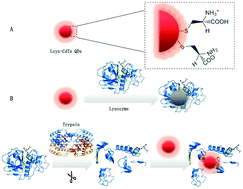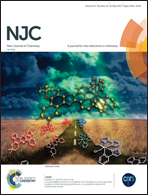l-Cysteine-capped CdTe quantum dots as a fluorescent probe for sequential detection of lysozyme and trypsin†
Abstract
In this work, we designed a simple and sensitive fluorescence probe for sequential detection of lysozyme and trypsin. Firstly, L-cysteine was chosen as a stabilizer to obtain L-cysteine-capped CdTe QDs. Lysozyme with positive charges can interact with L-cysteine capped CdTe quantum dots (QDs) via the special assembly between lysozyme and L-cysteine, resulting in the quenching of the fluorescence of CdTe QDs. Lysozyme can be hydrolyzed into small fragments in the presence of trypsin, and the interaction between L-cysteine-capped CdTe QDs and lysozyme would be inhibited, which could be used for trypsin quantification. There was a linear relationship between the fluorescence intensity of CdTe QDs and the lysozyme concentration in the range of 75–1000 ng mL−1 and another linear relationship between the fluorescence intensity of CdTe QDs and the logarithm of the trypsin concentration in the range of 10–500 ng mL−1. The detection limits were 28.33 ng mL−1 for lysozyme and 8.35 ng mL−1 for trypsin, respectively. The established method showed a good selectivity for lysozyme and trypsin detection.



 Please wait while we load your content...
Please wait while we load your content...